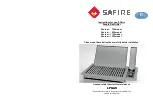
4
Additional safety instructions for impact drills
◆
Wear ear protectors
when impact drilling.
Exposure to
noise can cause hearing loss.
◆
Use auxiliary handles supplied with the tool.
Loss of
control can cause personal injury.
◆
Hold power tool by insulated gripping surfaces
when performing an operation where the cutting
tool may contact hidden wiring or its own cord.
Contact with a “live” wire will also make exposed metal
parts of the power tool “live” and shock the operator.
◆
Use clamps or another practical way to secure and
support the workpiece to a stable platform.
Holding
the work by hand or against your body leaves it unstable
and may lead to loss of control.
◆
Before drilling into walls, floors or ceilings check for the
location of wiring and pipes.
◆
Avoid touching the tip of a drill bit just after drilling, as it
may be hot.
Electrical safety
This tool is double insulated; therefore no earth wire
is required. Always check that the power supply
corresponds to the voltage on the rating plate.
◆
This appliance is not intended for use by young or infirm
persons without supervision. Children must be supervised
to ensure they do not play with the appliance.
Assembly
Warning!
Before assembly, make sure that the tool is
switched off and unplugged.
Fitting the side handle and depth stop (fig. A)
◆
Turn the grip counterclockwise until you can slide the side
handle (7) onto the front of the tool as shown.
◆
Rotate the side handle into the desired position.
◆
Insert the depth stop (6) into the mounting hole as shown.
◆
Set the drilling depth as described below.
◆
Tighten the side handle by turning the grip clockwise.
Fitting a drill bit or screwdriver bit
Keyless chuck (fig. B)
◆
Open the chuck by turning the front part (8) with one hand
while holding the rear part (9) with the other.
◆
Insert the bit shaft (10) into the chuck and firmly tighten
the chuck.
Keyed chuck (fig. C)
◆
Open the chuck by turning the sleeve (11) counterclockwise.
◆
Insert the bit shaft (10) into the chuck.
◆
Insert the chuck key (12) into each hole (13) in the side of
the chuck and turn clockwise until tight.
Removing and refitting the chuck (fig. D)
◆
Open the chuck as far as possible.
◆
Remove the chuck retaining screw, located in the chuck,
by turning it clockwise using a screwdriver.
◆
Tighten an Allen key into the chuck and strike it with
a hammer as shown.
◆
Remove the Allen key.
◆
Remove the chuck by turning it counterclockwise.
◆
To refit the chuck, screw it onto the spindle and secure it
with the chuck retaining screw.
Use
Warning!
Let the tool work at its own pace. Do not overload.
Warning!
Before drilling into walls, floors or ceilings,
check for the location of wiring and pipes.
Selecting the direction of rotation (fig. E)
For drilling and for tightening screws, use forward (clockwise)
rotation. For loosening screws or removing a jammed drill bit,
use reverse (counterclockwise) rotation.
◆
To select forward rotation, push the forward/reverse
slider (3) to the centre position.
5. Service
a.
person using only identical replacement parts.
ensure that the safety of the power tool is maintained.
b.
less.
Features
This tool includes some or all of the following features.
1. Variable speed switch
2. Lock-on button
3. Forward/reverse slider
4. Drilling mode selector
5. Chuck
6. Depth stop
7. Side handle
e. Maintain power tools. Check for misalignment or
binding of moving parts, breakage of parts and any
other condition that may affect the power tools
operation. If damaged, have the power tool repaired
before use. Many accidents are caused by poorly
maintained power tools.
f. Keep cutting tools sharp and clean. Properly
maintained cutting tools with sharp cutting edges are less
likely to bind and are easier to control.
g. Use the power tool, accessories and tool bits etc. in
accordance with these instructions, taking into
account the working conditions and the work to be
performed. Use of the power tool for operations different
from those intended could result in a hazardous situation.
5. Service
a.
person using only identical replacement parts. This will
ensure that the safety of the power tool is maintained.
b. Power to the tool should always be supplied via residual
current device with a rated residual current of 30mA or
less.
◆
If the supply cord is damaged, it must be replaced by the
manufacturer or an authorised Black & Decker Service
Centre in order to avoid a hazard.
Содержание AST1XC-XE
Страница 2: ...2 6 7 3 11 12 10 13 10 8 9 7 E C B D A F ...


























